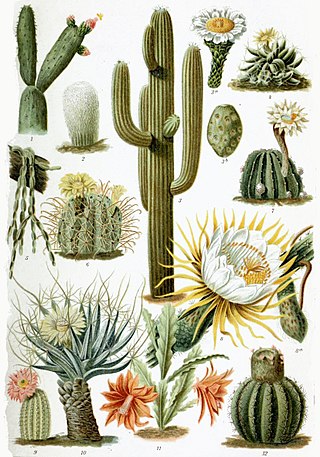
A cactus is a member of the plant family Cactaceae, a family of the order Caryophyllales comprising about 127 genera with some 1,750 known species. The word cactus derives, through Latin, from the Ancient Greek word κάκτος (káktos), a name originally used by Theophrastus for a spiny plant whose identity is now not certain. Cacti occur in a wide range of shapes and sizes. They are native to the Americas, ranging from Patagonia in the south to parts of western Canada in the north, with the exception of Rhipsalis baccifera, which is also found in Africa and Sri Lanka. Cacti are adapted to live in very dry environments, including the Atacama Desert, one of the driest places on Earth. Because of this, cacti show many adaptations to conserve water. For example, almost all cacti are succulents, meaning they have thickened, fleshy parts adapted to store water. Unlike many other succulents, the stem is the only part of most cacti where this vital process takes place. Most species of cacti have lost true leaves, retaining only spines, which are highly modified leaves. As well as defending against herbivores, spines help prevent water loss by reducing air flow close to the cactus and providing some shade. In the absence of true leaves, cacti's enlarged stems carry out photosynthesis.

Stenocereus is a genus of columnar or tree-like cacti from the Baja California Peninsula and other parts of Mexico, Arizona in the United States, Colombia, Costa Rica, Guatemala, Venezuela and the West Indies. The genus has been enlarged by the addition of species from several other genera. A close relative is the peculiar chinoa or chende cactus, Polaskia chende.

Bergerocactus emoryi is a species of cactus, known commonly as the golden-spined cereus, golden snake cactus, velvet cactus or golden club cactus. It is a relatively small cactus, but it can form dense thickets or colonies, with the dense yellow spines giving off a velvety appearance when backlit by the sun. From April to May, yellow, green-tinged flowers emerge, which transform into reddish, globular fruit. This species is native to the California Floristic Province, and is found in northwestern Baja California and a small part of California, in San Diego County and on the southern Channel Islands. Where the Mediterranean climate of the California Floristic Province collides with the subtropical Sonoran Desert near El Rosario, hybrids with two other species of cacti are found. It is the sole member of the monotypic genus Bergerocactus, named after German botanist Alwin Berger.

Epiphyllum is a genus of epiphytic plants in the cactus family (Cactaceae), native to Central America and South America. Common names for these species include climbing cacti, orchid cacti and leaf cacti, though the latter also refers to the genus Pereskia.
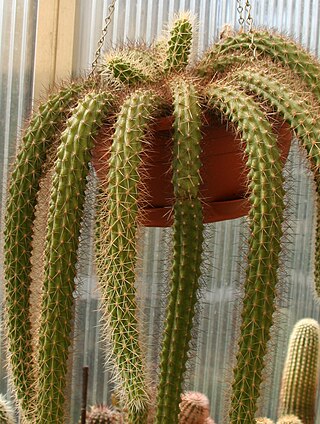
Morangaya is a monotypic genus of ribbed, usually small to medium-sized, cylindrical shaped cacti, that is native to north western Mexico. The only species is Morangaya pensilis. It is found in the mountains and rocky hills.

Grusonia is a genus of opuntioid cacti, originating from the North American Deserts in Southwest United States and northern Mexico, including Baja California. Authors differ on precise boundaries of the genus, which has been included in Cylindropuntia. Corynopuntia, also known as club chollas, is now a synonym, with the genus originally being described by Knuth in 1935. Molecular phylogenetic studies suggest that it should be included in Grusonia, a view accepted by Plants of the World Online as of June 2021.
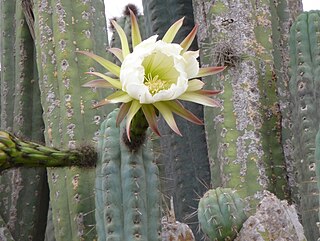
Echinopsis lageniformis, synonyms including Echinopsis scopulicola and Trichocereus bridgesii, is a cactus native to Bolivia. It is known as the Bolivian torch cactus. Among the indigenous populations of Bolivia, it is sometimes called achuma or wachuma, although these names are also applied to related species such as Trichocereus macrogonus which are also used for their psychedelic effects.

Selenicereus undatus, the white-fleshed pitahaya, is a species of the genus Selenicereus in the family Cactaceae and is the most cultivated species in the genus. It is used both as an ornamental vine and as a fruit crop – the pitahaya or dragon fruit.

Stenocereus thurberi, the organ pipe cactus, is a species of cactus native to Mexico and the United States. The species is found in rocky desert. Two subspecies are recognized based on their distribution and height. The Organ Pipe Cactus National Monument is named for the species. Cacti are minimally adapted to particular thermal niches, and are tremendously vulnerable to seasonal precipitation.
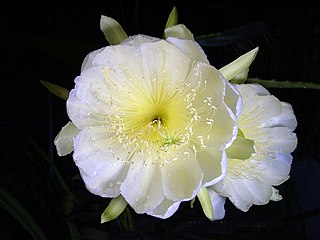
Selenicereus megalanthus, synonym Hylocereus megalanthus, is a cactus species in the genus Selenicereus that is native to northern South America, where it is known, along with its fruit, by the name of pitahaya. The species is grown commercially for its yellow fruit, but is also an impressive ornamental climbing vine with perhaps the largest flowers of all cacti.

Cereus repandus, the Peruvian apple cactus, is a large, erect, spiny columnar cactus found in South America. It is also known as giant club cactus, hedge cactus, cadushi, and kayush.

A pitaya or pitahaya is the fruit of several cactus species indigenous to the region of southern Mexico and along the Pacific coasts of Guatemala, Costa Rica, and El Salvador. Pitaya is cultivated in East Asia, South Asia, Southeast Asia, the United States, the Caribbean, Australia, Brazil, and throughout tropical and subtropical regions of the world.

The Huntington Desert Garden is part of The Huntington Library, Art Collections and Botanical Gardens in San Marino, California. The Desert Garden is one of the world's largest and oldest collections of cacti, succulents and other desert plants, collected from throughout the world. It contains plants from extreme environments, many of which were acquired by Henry E. Huntington and William Hertrich in trips taken to several countries in North, Central and South America.

Cylindropuntia echinocarpa is a species of cactus known by the common names silver cholla, golden cholla, and Wiggins' cholla. It was formerly named Opuntia echinocarpa.
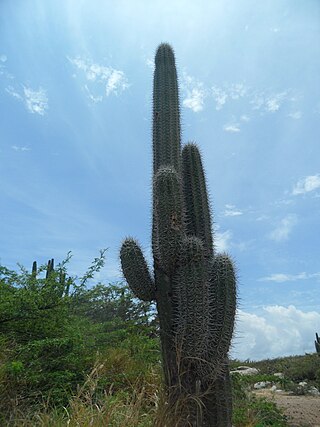
Stenocereus griseus, also known as the Mexican organ pipe, dagger cactus, pitaya, and pitayo de mayo, is a species of cactus.
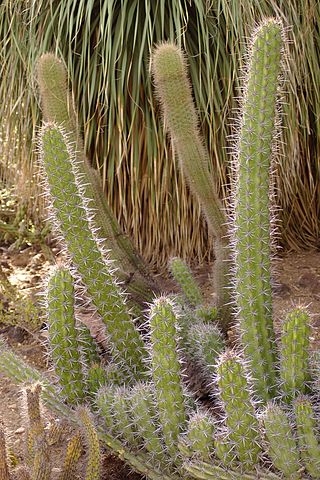
Stenocereus gummosus is a flowering plant in the family Cactaceae that is found in Baja California, Mexico at elevations of 9 to 134 meters
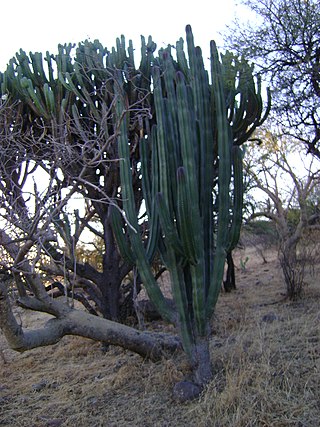
Stenocereus montanus, known as sahuira, is a species of columnar cactus in the family Cactaceae.
Stenocereus martinezii is a species of flowering plant in the family Cactaceae, native to Sinaloa in Mexico. A candelabriform cactus typically 5 to 7 m tall, it is easy to propagate from cuttings, so local people use it to build live fences.

Stenocereus treleasei, commonly known as tunillo, is a species of flowering plant in the family Cactaceae, native to Oaxaca in Mexico.

Echinocereus barthelowianus is a species of cactus native to Mexico.






















